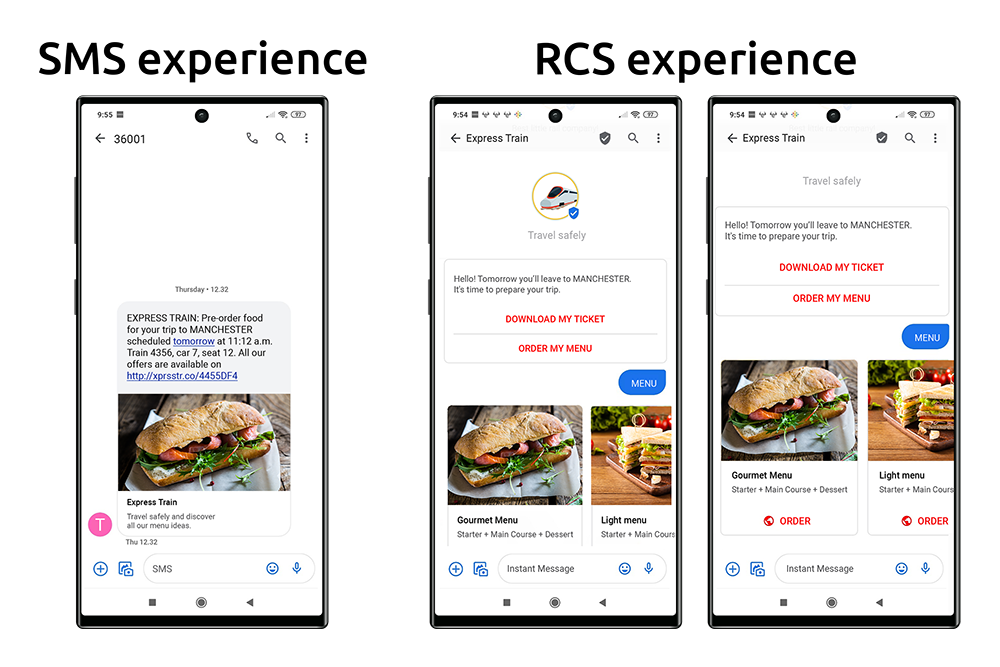The launch of RCS is imminent
Since RCS was specified as early as 2007, one could wonder why it took more than ten years to launch. Up to the point where several operators had already undertaken isolated initiatives… The answer to this observation is simple: RCS deployment is complex. To get off the ground, it must succeed in meeting three major prerequisites:
- a compatible OS and this is precisely what Google has set out to do from 2017, namely to ensure that the Android OS, known for its fragmentation, can support this communication protocol,
- compatible messaging is needed, and even if Google makes its OTT Messages (also available on Google Play) available to equipment manufacturers, they all add an overlay of proprietary services to Android. Messaging pre-installed on the smartphone is part of the strategic services with the browser,
- finally, access to the telecom network where an RCS-provisioned device is required: RCS is based on the IP protocol and therefore remains completely in the hands of the telco operator.
This complexity results in very strong local heterogeneity in the global spread of RCS. It is therefore not surprising that RCS also has its detractors, considering that this standard will never be able to overcome all these obstacles. This is where Google plays a leading role in promoting the RCS to equipment manufacturers (using Android), operators (to whom it also offers technical solutions facilitating its deployment on their networks), and consumers (being able to download Messages on Google Play).
Over 25% of smartphone owners could be RCS-enabled by the end of the year
While penetration rate and RCS acceptance varies by geography, Samsung, the biggest smartphone manufacturer in the Android ecosystem, is deploying RCS capabilities fast.
Some questions remain open: what is the cost going to be, and how far will the use cases go? To date, the economic model has not yet been completely settled and, as it depends on the commercial policy of each operator, a certain degree of heterogeneity cannot be ruled out. Nevertheless, a consensus is emerging: as the RCS favours conversational exchanges, a session-based billing system is expected. In order to allow the sending of information messages that do not invite conversation but whose multimedia format would be more relevant than a simple SMS text, an intermediate rate between conversation and SMS will probably be proposed. The pricing equation is a sensitive issue for the success of RCS. In 2007, MMS, which was also promising, failed to make a name for itself for both technical and pricing reasons. It was considered too expensive in relation to the benefits it brought vs. SMS.
RCS is both a client activation channel and an open channel for application use.
In terms of use cases, the market should, for technical reasons, first focus in 2020 on so-called A2P (application-to-person) uses before opening up to P2A (person-to-application) uses. In other words, brands will first be able to contact their mobile optin customers (and Android device owners) via RCS, but eventually customers will also be able to contact the brand via this channel. The two modes are truly complementary in terms of marketing interest.
Thanks to A2P, brands will be able to:
- Trigger more impactful tactical campaigns thanks to way more detailed and interactive capabilities with regards to drive-to-store and product promotion.
- Reinforce their CRM at key moments in the customer journey by setting up reinsurance sequences (onboarding new customers, post-purchase, post-claims, etc.).
And in P2A, brands will also be able to:
- Set up a new customer contact point directly accessible from the messaging system (Q&A, customer account management, appointment scheduling…).
- Allow 1-click purchases (booking a transport ticket, a show ticket, a hotel room, a new product in presale…).
RCS is both a client activation channel and a channel open to application uses: many of the use cases restricted until now to mobile applications can be deployed in mobile messaging thanks to RCS. The main task for brands consists in identifying these use cases and prioritizing them in order to bring them to life via a conversational decision tree. It is important to note that conversational does not require NLC (natural language comprehension), a decision tree built on click navigation is just as effective at this stage.
The investment of brands in RCS seems all the more important since arbitrages for apps have been a real headache between expensive acquisition strategies and a never ending retention issue. As for OTT initiatives, they have also quickly come up against limitations around contact data because retrieving a customer’s token to activate it in OTT can be long and costly. These messaging systems are basically designed for P2P (person-to-person), not for A2P. RCS in this sense is different. It is an extension of the A2P SMS, to which it is complementary, by offering an activation capacity from the mobile number, while promising accessibility without downloading any prerequisites because it is native to the terminal’s messaging system. For all brands whose business is not “App centric”, RCS appears as a game changer in their mobile strategy. Apple, which is known to be pro-application, is for the moment choosing to stay away from RCS because of iMessage, but in the long run, interoperability of these standards could make sense for consumers. For brands, reaching their Android customers is already a great challenge and offers the biggest potential. Google’s OS takes up 86% smartphone market share worldwide.
RCS fits perfectly in this marketing paradigm shift: Mobile First
RCS is a new mobile messaging channel after SMS, push notification, wallet notifications, or OTT (from which each platform must be separated: Messenger, WhatsApp, Viber, etc.). We will have to learn how to identify the best activation channels according to customer profiles or to the objectives set by each brand. RCS is very rich and therefore more complex to master than SMS. But RCS is all the more interesting since its appearance should help fill a gap between SMS and mobile applications. It is a great innovation in mobile marketing and it is in the interest of all, publishers, equipment manufacturers, operators, service providers, consumers and brands, that its launch is a success. In Spring, Numberly contributed to the MMA France mobile marketing barometer: at the end of 2019, 65% of consumers opened more than 75% of their marketing emails on their smartphones. Behaviors have changed and RCS is perfectly in line with Mobile First.

